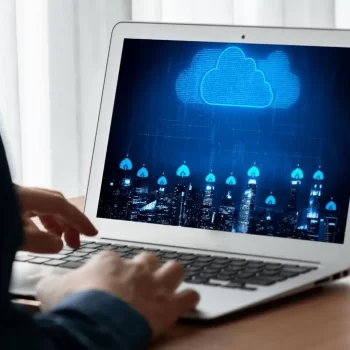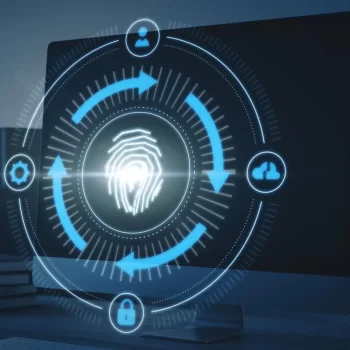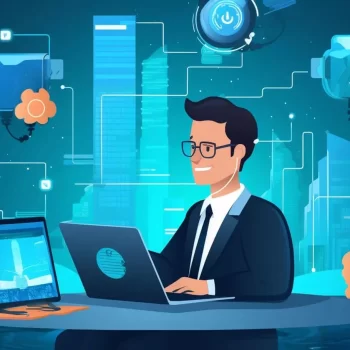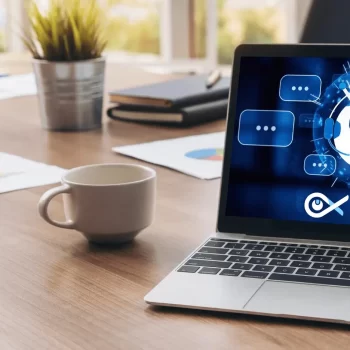With technology advancements, will cybersecurity stay important in 2030?
Are MSPs preparing for the challenges and opportunities in the changing cybersecurity of 2030?
How are MSPs preparing for the increasing cyber threats as technology evolves in the next decade?
How can MSPs build a strong workforce in the face of the expected shortage of cybersecurity professionals?
How will technology and cyber threats shape the role of MSPs in the future, and what strategies can they use?
Considering their crucial role in securing digital ecosystems, how can MSPs help adapt to the changing technology in 2030?
In this blog, you will discover the challenges and opportunities that lie ahead for MSPs in the field of cybersecurity over the next decade.
Related article: Data Privacy: How MSPs Can Safeguard Client Information
What are MSPs? How MSPs Secure Cyber Resilience?
MSPs, or Managed Service Providers, deliver IT services to businesses on a subscription model. Their essential role in cybersecurity positions them as guardians of digital resilience against evolving cyber threats. Their role includes managing and maintaining clients’ IT infrastructure, offering proactive services to prevent issues, and providing expertise and comprehensive solutions for a resilient digital environment. Here are critical aspects of the role of MSPs in cybersecurity:
- Proactive Security Measures: MSPs employ proactive measures to identify potential cyber threats before they escalate. Continuous monitoring and advanced threat detection are essential in safeguarding organizations against evolving risks.
- Comprehensive Defense Strategies: The service providers offer complete cybersecurity solutions beyond traditional measures. They secure endpoints, monitor networks, and fortify cloud infrastructure, ensuring a multi-layered defense strategy tailored to the specific needs of their clients.
- Rapid Incident Response: MSPs are equipped to respond to a cybersecurity incident. Their expertise allows for identifying, containing, and resolving security breaches, minimizing potential damages, and enhancing overall resilience.
- Expertise in Compliance: Navigating the complex nature of cybersecurity regulations can be challenging. MSPs bring specialized knowledge of compliance requirements, assisting organizations in meeting industry standards and regulatory frameworks, such as those outlined in the NIST Cybersecurity Framework. Understanding what is NIST cybersecurity framework can help organizations align with these best practices.
- Scalability and Adaptability: MSPs provide scalable solutions, adjusting security measures based on an organization’s evolving needs and size. This adaptability ensures that businesses receive tailored defense strategies.
MSPs are necessary to strengthen organizations against cyber threats. They offer expertise, holistic solutions, and adaptable strategies to navigate the contemporary cybersecurity landscape.
Navigating the Future: Unveiling the Evolving Threat Landscape in 2030
In the IT industry, the next decade marks a transformative phase in the cybersecurity market. Driven by technological advancements, cyber threats are poised to reshape digital defense. This exploration helps to look into the evolving threat, analyzing emerging attacks and tactics that will impact organizations in the IT sector in the years ahead.
Emerging Cyber Threats in 2030:
a. Quantum Computing Threats: Quantum computing poses unique challenges, demanding a comprehensive understanding of potential risks. Quantum’s disruptive influence can render encryption methodologies obsolete, requiring IT entities to respond strategically.
b. AI-Powered Attacks: Artificial intelligence emerges as a tool for defenders and a challenging weapon in the hands of cyber adversaries. The rise of AI-driven attacks with adaptive and real-time learning capabilities presents a complex challenge requiring proactive measures for mitigation.
c. Biometric Data Exploitation: The surge in biometric authentication introduces a new dimension of risk associated with exploiting highly personal data. Safeguarding sensitive information emerges as a critical imperative for IT organizations.
Analysis of New Attack Vectors and Tactics:
a. Supply Chain Attacks: Cybersecurity threats are increasingly evident within the interconnected supply chain ecosystem. From software vendors to third-party service providers, IT entities must fortify defenses against the sophisticated nature of supply chain attacks.
b. 5G-Enabled Threats: As 5G technology becomes omnipresent, the potential for novel cybersecurity threats amplifies. The heightened connectivity and increased speeds of 5G networks expose vulnerabilities that demand robust security measures and proactive risk management.
c. Deepfake and Manipulated Content: The proliferation of deepfake technology, capable of creating convincing manipulated content, introduces risks of disinformation and impersonation. IT organizations must prioritize advanced detection and prevention mechanisms to counter these emerging threats.
Strategies for Future Defense:
a. Proactive Threat Intelligence: IT organizations must invest in proactive threat intelligence capabilities in the face of evolving threats. Staying ahead of adversaries necessitates an in-depth understanding of emerging threats and potential vulnerabilities.
b. Continuous Training and Awareness: The human element remains critical in cybersecurity incidents. Continuous training and awareness programs within IT organizations are essential to promoting the human component of cybersecurity and identifying the risks associated with human error.
c. Integration of Advanced Technologies: Leveraging advanced technologies such as machine learning, behavioral analytics, and automated response systems is imperative for the IT industry. These technologies enhance the ability to identify and respond quickly to emerging threats in real-time, reinforcing the resilience of IT systems.
As the IT industry charts its course into 2030, a proactive and strategic approach to cybersecurity becomes paramount. Understanding the distinctions of emerging threats and embracing innovative defense strategies will empower IT organizations to navigate the evolving landscape, ensuring a secure digital future.
Technology Trends Shaping Cybersecurity
As the digital environment continues to evolve, technology trends are reshaping the contours of cybersecurity, demanding innovative approaches to safeguard sensitive information and digital assets. In this exploration, we delve into three pivotal technological trends that have a transformative influence on cybersecurity.
- Role of AI and ML in Cybersecurity: In the battle of cyber threats, AI and ML are formidable allies. AI and ML technologies empower cybersecurity systems to analyze vast datasets, identify patterns, and adapt to evolving threats in real-time. Integrating AI and ML enhances the agility and effectiveness of cybersecurity defenses, from predictive threat modeling to anomaly detection. Automated response mechanisms driven by these technologies enable swift action, mitigating potential risks before they escalate.
- Quantum Computing and Encryption: Quantum computing holds immense promise for solving complex problems; it simultaneously poses a substantial challenge to traditional encryption methodologies. The computational capabilities of quantum computers, leveraging like algorithms, could compromise widely used encryption techniques. As organizations handle future threats, the quest for quantum-resistant cryptographic algorithms becomes imperative. Cybersecurity must evolve with quantum advancements, ensuring the development and adoption of quantum-safe cryptographic protocols to maintain data confidentiality in the quantum era.
- IoT (Internet of Things) and the Challenges it Brings to Security: The proliferation of Internet of Things devices introduces a vast attack surface, presenting unique challenges to cybersecurity. The interconnected nature of IoT devices, ranging from smart appliances to industrial sensors, amplifies the potential impact of security breaches. Vulnerabilities within IoT ecosystems, if exploited, can lead to unauthorized access, data breaches, and even disruptions in critical infrastructure.
Securing the IoT landscape requires robust authentication, encryption, and monitoring mechanisms to mitigate the inherent risks associated with the interconnectivity of these devices. Organizations must remain vigilant of these technology trends in navigating the dynamic cybersecurity landscape.
Embracing the potential of AI and ML for proactive defense, preparing for the quantum era by adopting quantum-resistant encryption, and fortifying cybersecurity strategies to address the complexities of IoT ecosystems are essential imperatives. Organizations can establish their resilience and prevent cyber threats by staying at the forefront of these technological shifts.
Navigating the Hurdles: Key Challenges Encountered by MSPs
In the ever-evolving cybersecurity landscape, MSPs face many challenges that necessitate strategic adaptation and innovative solutions. As they navigate the intricate terrain of digital defense, the following difficulties emerge as significant hurdles:
- Increased Sophistication of Cyber Threats: The relentless evolution of cyber threats poses a considerable challenge for MSPs. Cyber adversaries continually enhance their tactics, employing advanced techniques such as ransomware, zero-day exploits, and sophisticated social engineering. MSPs must constantly stay ahead of these evolving threats, investing in cutting-edge technologies and proactive defense strategies to ensure robust protection for their clients.
- Shortage of Skilled Cybersecurity Professionals: The need for skilled cybersecurity professionals compounds MSPs’ challenges. The high demand for expertise in this field often outpaces the availability of qualified professionals. MSPs must address this talent gap by implementing comprehensive training programs, boosting skill development, and strategically leveraging technology to augment their workforce.
- Balancing Security and User Experience: Achieving an optimal balance between security measures and user experience presents a delicate challenge for MSPs. Stringent security protocols can sometimes impede user productivity and create friction. MSPs need to implement security solutions that seamlessly integrate into the user experience, ensuring that robust protection does not compromise the efficiency and usability of the systems they manage.
Seizing Opportunities: Potential for MSPs
While challenges abound, MSPs also find themselves at the connection of significant opportunities within the increasing cybersecurity environment. These opportunities not only open new avenues for growth but also position MSPs as instrumental players in the ongoing battle against cyber threats:
- Growth of the Cybersecurity Market: The escalating frequency and complexity of cyber threats have fueled a substantial increase in the cybersecurity market. MSPs can capitalize on this surge in demand by offering comprehensive cybersecurity services. By positioning themselves as trusted partners in digital defense, MSPs can expand their market share and contribute significantly to the overall cybersecurity ecosystem.
- New Service Offerings and Business Models: The evolving threat landscape demands innovative and specialized cybersecurity services. MSPs can seize this opportunity by diversifying their service offerings to include advanced threat intelligence, incident response, and compliance management. Exploring new business models, such as subscription-based security services, allows MSPs to align their offerings with evolving client needs.
- Collaborative Approaches to Cybersecurity: Collaboration is becoming increasingly crucial in the fight against cyber threats. MSPs can promote partnerships with other cybersecurity experts, technology vendors, and industry stakeholders. Collaborative approaches enable the sharing of threat intelligence and the development of comprehensive solutions, strengthening the collective defense against cyber adversaries.
Navigating these challenges and embracing these opportunities, MSPs can fortify their position as essential guardians of digital resilience and contribute significantly to advancing the cybersecurity landscape. The ability to strategically address challenges and leverage emerging opportunities will be crucial in defining the success of MSPs in this dynamic and critical domain.
Related article: ITOps in 2024: What’s Changed and What’s Next?
Data Privacy and Ethical Considerations
The integration of next-generation security technologies has become imperative to fortify cyber defenses. Among these innovations are:
- Zero Trust Security: The Zero Trust security model, a shift from traditional approaches, advocates for perpetual verification of every user, device, and application attempting to connect to a network. Organizations can enhance their security posture by rejecting the assumption of trust within a network and requiring continuous verification. This model minimizes the risk of unauthorized access and data breaches, making it a pivotal element in modern cybersecurity strategies.
- Blockchain in Cybersecurity: Blockchain, initially the technology behind cryptocurrencies, has found application in enhancing cybersecurity. Its decentralized and tamper-resistant nature enhances the integrity of data. In cybersecurity, blockchain is leveraged to secure transactions, authenticate user identities, and create transparent and immutable records. By adopting blockchain, organizations can enhance the trustworthiness and security of their digital commerce and communications.
- Cloud-Native Security Solutions: The widespread adoption of cloud computing necessitates security measures inherently designed for the cloud environment. Cloud-native security solutions encompass a range of tools and practices, including identity and access management, encryption, and threat intelligence.
These measures ensure comprehensive security for data and applications hosted in the cloud, aligning cybersecurity defenses with the dynamic nature of cloud-based operations.
Future-Proofing Cybersecurity Strategies
As organizations strive to future-proof their cybersecurity strategies, several vital considerations come to the forefront:
- Building Resilient Cybersecurity Infrastructures: Future-proofing cybersecurity requires a proactive approach to building resilient infrastructures. This involves continuous investment in advanced technologies such as AI and machine learning, regular updates to security protocols, and the integration of threat intelligence. Resilient infrastructure is foundational to withstanding and mitigating evolving cyber threats.
- Developing Incident Response and Recovery Plans: Cybersecurity incidents are inevitable, and organizations must have quick incident response and recovery plans. These plans should encompass clear protocols for identifying, containing, and mitigating security breaches. In addition, they must include steps for recovery, ensuring minimal disruption and loss of data due to an incident. Regular testing and refinement of these plans are essential to their effectiveness.
- Importance of Continuous Monitoring and Assessment: Continuous monitoring and assessment are necessary in a dynamic cybersecurity landscape. Organizations need real-time visibility into their networks, applications, and data to detect and respond swiftly to emerging threats. Regular assessments help to identify potential weaknesses and reinforce cybersecurity defenses. Continuous improvement based on monitoring and assessment results ensures that security measures remain effective against evolving threats.
Related blog: Fraud prevention and detection: ITSM’s role in banking security
Conclusion:
The upcoming decade presents MSPs with challenges and opportunities within cybersecurity. In advancing technology, the crucial role of MSPs becomes increasingly evident. MSPs emphasize their focus on proactive measures, collaborative initiatives, and the strategic adoption of advanced technologies. Positioned as digital guardians, MSPs are not merely reactive but composed to proactively navigate challenges, harness the expanding cybersecurity market, and significantly contribute to shaping a secure digital future.



















